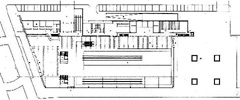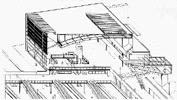| Con fecha 23
de Mayo de 1994 se firmó el Convenio para la construcción de una variante
ferroviaria en Castellón, que incluía la construcción de una nueva
estación ferroviaria en la ciudad, se acordó realizar un concurso de ideas
con el objeto de definir conceptual, tipológica y arquitectónicamente un
edificio para estación de viajeros. El proyecto presentado bajo el lema
"Destino Luz" obtuvo el primer premio.
"Era deber de la arquitectura del
ferrocarril dar seguridad al tímido viajero", decia un observador de las
viejas estaciones. Seguridad y bienvenida, una auténtica plaza protegida
de las inclemencias del tiempo, lugar urbano por excelencia. Nuevas
puertas de entrada a la ciudad.
La estación de Crown Street en
Liverpool, allá por 1830, tenía ya todas las características básicas en
forma embrionaria: el patio de vehículos anticipando las avenidas
cubiertas de las estaciones posteriores, una sala de espera y venta de
billetes y la plataforma en la que se alcanzaban los vagones bajo la
cubierta de una gran nave.
Dejamos al descubierto las vías a su
paso por la nueva estación, haciendo que el sol inundara los andenes,
interrumpiendo la monótona secuencia del túnel interponiendo la gran nave
como caja filtradora de luz, ahora ya "origen o destino", referencia que
materializa la vocación de estación término, aún siendo tránsito, la nave
cívica, el edificio definitivamente urbano y público, el umbral simbólico
de la ciudad: la memoria de las antiguas estaciones y su experiencia
espacial revivida.
Un sencillo esquema: la nave cubre
las vías y aloja las plataformas transversales de comunicación entre
andenes, una edificiación lineal siguiendo la misma directriz recoge los
servicios y oficinas. Al quedar las vías en otro nivel los laterales se
cierran atendiendo a la posición relativa de la estación en su entorno
urbano. De un lado prolongada hacia la estación de autobuses a través de
un espacio abierto, de pasos, de comunicación y trasiego de personal y
equipajes. Al sur una verdadera fachada, oblicua, hacia la plaza
triangular, para solventar una lateralidad forzada, el acceso principal al
edificio, al vestíbulo balcón sobre las vías, la fachada con el gran reloj
de cuartos saledizos recordando los relojes de sol y la
marquesina.
La nave es una gran lonja
mediterránea, recoge parte del tejido viario que se adentra materializando
los accesos y circulación transversales en la dirección de la calle
Cronista Muntaner. La cubierta presenta dos caras: una exterior
plana, barrera física a las inclemencias y al sobrecalentamiento; otra
interior curvada y suspendida que engloba al espacio, rasgada para filtrar
la luz, también para difundir lo que llega a través del muro tronera del
oeste con grandes diafragmas... la fachada hacia la gran avenida,
acristalada tambien para hacer participe al viandante del gran agujero de
las vías. Las bandejas matizarán la luz en altura. |
On 23 May
1994 the Agreement to reroute the railway through Castellón was signed.
This included building a new railway station for the city. The
decision was taken to convene an ideas competition in orden to
define the concept, type and architecture of the station building for rail
passengers. The project submitted under the pseudonym "Destino Luz"
(Destination Light) won the first prize.
As an observer of the old railway stations
said: "It was a duty of railway architecture to reassure the timid
traveller". Security and welcome, then, as the station could already be
considered a genuine public square protected fron the vagaries of the
weather, an urban space par excellence: the new entrance gates to the
city.
Around 1830, Crown Street station in Liverpool
already possessed al the basic features in embryonic form: the vehicle
yard foreshadowing the covered avenues of later stations, a waiting room
and ticket office, the platform for boarding the carriages under the cover
of a wide span roof.
We shall leave the railway lines open as they
pass through the new station, allowing the sun to flood the platforms,
interrupting the monotonous sequence of the tunnel by inserting a great
nave like a box that filters the light. Now it is already "origin or
destination", terms that encapsulate its vocation to be a terminus station
even if it is one of transit; it isthe civic nave, the definitively urban
and public building, the symbolic threshold of the city, reliving the
memory of the old stations and their spatial
experience.
A simple plan: the nave covers the lines and
contains the transverse platforms that communicate one railway platform
with another; a linear building aligned in the same direction contains the
services and offices. As the lines are at a different level, the sides are
closed, vearing in mind the station´s position in relation to its urban
environment. On one side it reaches towards the bus station through an
open space, one of passage, of communication and movement of people and
baggage. To the south, a true facade, oblique, gives on to the square,
wich is triangular in order to solve the inforced laterality.
This facade with its great clock with the
quarter hours in relief, remiiscent of sundials and a canopy, is
the main access to the building and to the balcony-hall over the
lines.
The nave is a great Mediterranean portico. It
gathers in part of the network of roads that embody the crossways accesses
and circulation as they percolate towards Cronista Muntaner street. The
roof shows two faces: the exterior is flat, a physical barrier to the
weather and to overheating; the other, the interior face, is curved and
suspended, encompassing the space. It is torn to filter the light and
disseminates the light that enters though the west wall of windows with
great diaphragms... the facade onto the great avenue is also glazed so
that the passer-by can be drawn into the great cavern of the railway
lines. The trays tone down the light from on high. |
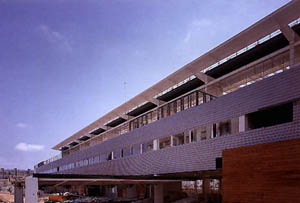
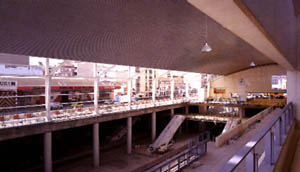
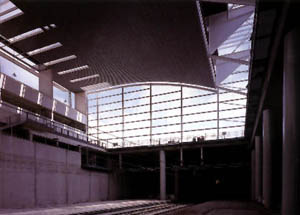
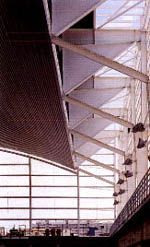
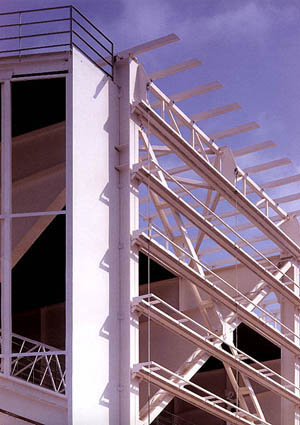
|
El
proyecto
La evolución de la estación hay que
entenderla desde la interacción de múltiples factores que la condicionan,
a veces difíciles de individualizar:
– conjunción de coluntades
políticas con diversas administraciones
implicadas;
–ser infraestructura de primer orden,
vertebradora del territorio;
–impacto urbanístico
ensu entorno inmediato y en el global de la
ciudad;
–edificio complejo, concaracterísticas
singulares en su funcionamiento, estructura, construcción, materiales,
diseño e imagen urbana.
El edificio se plantea desde sus
inicios como una "caja filtradora de luz" que la conduce, matizada, hasta
los andenes en el túnel. La formalización de una gran nave de acotida,
rica espacialmente, que juega con elementos de escala y aprovecha el gran
desnivel existente entre la calle y las vías se concreta con tres
materiales básicos: hormigón blanco visto, acero y cristal. Y una clara
intencionalidad: las soluciones estructurales debían dejarse vistas, sin
más tratamientos u ocultaciones urteriiores. Este planteamiento escueto y
sincero ha servido para introducir disciplina, ciudado y limpieza enla
elaboración de los elementos estructurales, una composición esmerada de
las mezclas, tratamiento específico de uniones, etc.
Haber logrado mantener la concepción
inicial no ha sido fácil. Intereses de todo tipo, especialmente
economicistas, tienden a aliarse para proponer alternativas que "guarden
la apariencia" de proyecto pero con materiales y/o soluciones que
cambiarían radicalmente la manera de percibir/vivir el
edificio.
Ha sido necesaria una ardua labor de
pedagogía con todas las parte. Analizando cada momento de obra para
introducir de forma coherente los elementos nuevos. Y no siempre se
hasaldadl favorablemente. Materiales de acabado y alguna dotación de
instalaciones serían los apartados donde se han producido los cambios más
significativas: desaparición de pasarela y rampas de paquexpres bajo
lafachada Norte, pasando a ser un túnel y rampasbajo andenes; modificación
de los núcleos de transporte vertical andenes-vestibulo, con sustituciónde
rampas mecánica por escalerasmecànicas; variación constructiva/estructural
del muro Sur: inicialmente de doble hoja visitable interiormente y ahora
macizo con menor espesor; sustitución de la chapa de aluminio de la
cubierta interior por chapa de acero; utilización de un acristalamiento de
menor transmisión luminosa ymás reflectante; sustitución de los materiales
de acabado de la fachada Oeste: composite de aluminio Alucobond por chapa
de acero, y tableros fenólicos por madera de teka vacsolizada; cambio
derivados de intruducir equipos mecánicos de ventilación y control
medioambiental que afectan sobre todo a los lucernarios de cubierta y
fachada Oeste; simplificación de numerosos acabados en paramentos
interiores; sustitución de sistemas de iluminación en vestíbulo y zonas
comunes;...
La obra continúa. Sobre algunos
temas aquí citados no se ha omado una decisión final. Sin embargo, después
de todo lo expuesto, debemos admitir que hasta ahora el resultado/proceso
es globalmente positivo y satisfactorio. |
The project
The
reason why the station has evolved as it has is the product of the
intereaction of the multiple factors that condition it, which are
sometimes hard to pin down.
–the meeting of the political wills of the
various administrations involved
–its being an
infrastructure of the first order, structuring a large
territory
–its urbanistic impact on its inmediate
environment and on that of the city as a whole
–its
being a complex building with singular features in its functioning,
structure, construction, materials, design and urban
image.
From the start, the building was conceived as a
"box to filter light", leading it, diffused, down to the platforms in the
tunnel. The formalisation of a great welcoming nave, a mediterranean
portico, spatially rich, that plays with elements of scale and makes use
of the great difference in level between the street and the lines, is
carried out in three basic meterials: bare white concrete, steel and
glass. The intention is clear: the structural solutions must remain in
view with no further treatment or concealment. This bare, sincere approach
has served to introduce discipline, care and cleanliness in the
construction of the structural elements, a meticulous composition of the
mixes, specific treatment of joins, etc.
This is so. Bur managing to preserve the
initial concept has not been easy. Interests of every tupe, particularly
financial, tend to join forces to propose alternatives to "keep up the
appearances" of the project while using materials and/or solutions that
would rdically change the manner of perceiving/living the
building.
It has proved necessary to undertake an arduous
education of all the partries involved and to analyse every instant of the
work so that the new elements are introduced in a coherent way. And
the result has not always been positive. The finishing materials and
certain installations are the chapters that have undergone the greatest
changes: the paquexpres gangway and ramps beneath the north façade have
disappeared, becoming a tunnel and ramps under the platforms. The vertical
transports between the hall and the platforms have been modified and the
moving ramps have become moving staircases. A construction/structural
variation in the south wall: initilly double wythe and passable within,
now solid and less thick. The aluminium sheet of the inner roof has been
replaced by stainless steel sheet. Use of a glazing with greater
reflectance that lets thoruogh less light. Replacement of the finishing
materials on the west façade: steel sheet instead of Alucobond aluminium
composite and phenol boards instead of vacsolized teak. Changes due to
introducing mechanical ventilation and climate control equipment, which
mainly affect the skylights in the roof and west façade. simplification of
munerous finishes on the interior walls. Replacement of lighting systems
in hall and public areas...
The work continues. A final decision has not
yet been taken on some of the matters mentioned here. However, despite all
the foregoing, we must admit that so far the process/result is globally
positive and satisfactory. |











